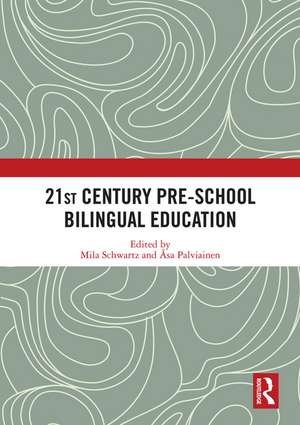21st Century Pre-school Bilingual Education
Editat de Mila Schwartz, Åsa Palviainenen Limba Engleză Paperback – 30 iun 2020
The book highlights the need on the one hand to examine early bilingual education within specific socio-cultural contexts, and on the other to search for its universal features. It aims to promote the field of preschool bilingual education as a unique research domain by illustrating its distinctiveness. Last but not least, the studies presented here have a significant contribution to make in the light of the growing interest of policy-makers, ethno-linguistic community leaders, practitioners and researchers in early bilingual development and education. This book was originally published as a special issue of International Journal of Bilingual Education and Bilingualism.
Preț: 372.08 lei
Nou
Puncte Express: 558
Preț estimativ în valută:
71.21€ • 73.78$ • 59.43£
71.21€ • 73.78$ • 59.43£
Carte tipărită la comandă
Livrare economică 21 martie-04 aprilie
Preluare comenzi: 021 569.72.76
Specificații
ISBN-13: 9780367585495
ISBN-10: 0367585499
Pagini: 132
Dimensiuni: 174 x 246 x 8 mm
Greutate: 0.36 kg
Ediția:1
Editura: Taylor & Francis
Colecția Routledge
Locul publicării:Oxford, United Kingdom
ISBN-10: 0367585499
Pagini: 132
Dimensiuni: 174 x 246 x 8 mm
Greutate: 0.36 kg
Ediția:1
Editura: Taylor & Francis
Colecția Routledge
Locul publicării:Oxford, United Kingdom
Public țintă
Postgraduate, Professional, and UndergraduateCuprins
Introduction- Twenty-first-century preschool bilingual education: facing advantages and challenges in cross-cultural contexts 1. Two languages in the air: a cross-cultural comparison of preschool teachers’ reflections on their flexible bilingual practices 2. Adult monolingual policy becomes children’s bilingual practice: code-alternation among children and staff in an English-medium preschool in Sweden 3. The early childhood education and care partnership for bilingualism in minority language schooling: collaboration between bilingual families and pedagogical practitioners 4. ‘Why do we know Hebrew and they do not know Arabic?’ Children’s meta-linguistic talk in bilingual preschool 5. Nurturing bilingual learners: challenges and concerns in Singapore 6. First-language skills of bilingual Turkish immigrant children growing up in a Dutch submersion context
Notă biografică
Mila Schwartz is Associate Professor in Language and Education and a Head of Language Program (MA) in Oranim Academic College of Education, Israel. Her research interests include studying language policy and models of early bilingual education; language, cognitive, and socio-cultural development of early sequential bilinguals; family language policy; and bilingual teachers' pedagogical development.
Åsa Palviainen is a full Professor in Swedish at Department of Languages at the University of Jyväskylä, Finland. Her research covers a wide range of topics including language policy issues and discourses (especially on the status of Swedish in the Finnish educational system and on bilingualism), discourse analytical and sociolinguistic approaches to early bi- and multilingualism, language policies and practices in early childhood education, family language policy research, and innovative L2 teaching and learning.
Åsa Palviainen is a full Professor in Swedish at Department of Languages at the University of Jyväskylä, Finland. Her research covers a wide range of topics including language policy issues and discourses (especially on the status of Swedish in the Finnish educational system and on bilingualism), discourse analytical and sociolinguistic approaches to early bi- and multilingualism, language policies and practices in early childhood education, family language policy research, and innovative L2 teaching and learning.
Descriere
This book offers a timely focus on preschool bilingual education in the 21st century. It illustrates the need to examine early bilingual education within specific socio-cultural contexts, as well as to search for its universal features. It was first published as a special issue of
